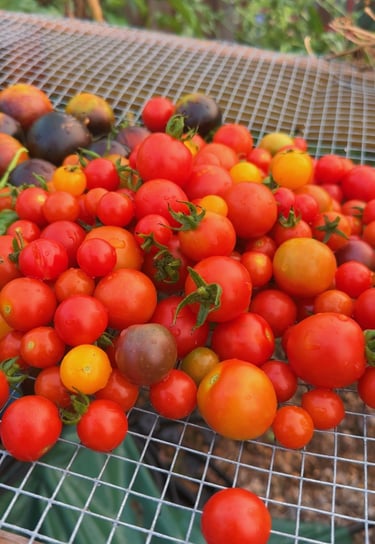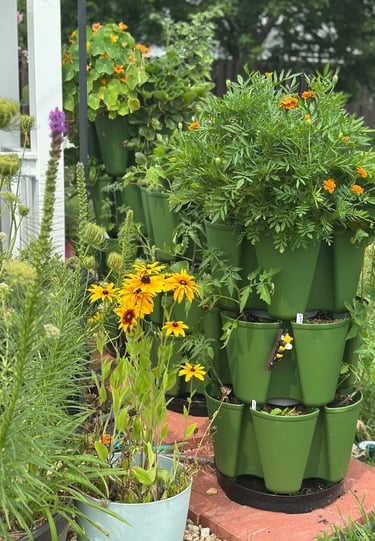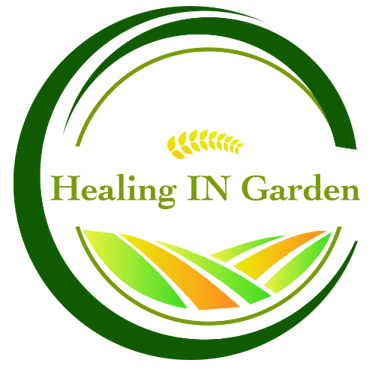Summer Gardening in Northern Virginia (Zone 7): What to Grow, How to Care, and Ways to Preserve Your Harvest
6/27/20255 min read


What to Grow in Zone 7 During Summer
Gardening enthusiasts in Northern Virginia, classified as USDA Zone 7, can enjoy a rich array of vegetables and herbs during the summer months. The region's warm temperatures and humidity levels create ideal growing conditions for a variety of crops. Among the most popular choices are tomatoes, a staple in many summer gardens. Varieties such as slicing, cherry, and Roma thrive in this zone, each offering unique flavors and uses. Slicing tomatoes are perfect for sandwiches and salads, while cherry tomatoes make excellent snacks or additions to summer dishes. Roma tomatoes, with their dense flesh, are ideal for sauces and canning.
Another recommended crop is peppers, which also flourish in Zone 7's heat. Bell peppers provide a sweet crunch to salads and stir-fries, while jalapeños add a spicy kick to various recipes. Banana peppers, known for their mild flavor, can be used pickled or in salads. When selecting pepper varieties, consider choosing those that mature within the season to ensure a successful harvest.
Timing is crucial when planting these summer crops. Generally, it is advisable to start planting tomatoes and peppers after the final frost date, which typically falls in mid-April to early May in Northern Virginia. This timing allows the soil to warm sufficiently to promote healthy root development. Additionally, considering companion planting can further enhance yields and deter pests. For instance, pairing tomatoes with basil can improve their flavor while protecting them from certain diseases. Similarly, planting peppers alongside basil can enhance their growth and overall health.
By selecting the right varieties and following optimal planting times, gardeners in Northern Virginia can cultivate a thriving summer garden filled with flavorful produce and aromatic herbs. Proper planning and companion planting strategies can lead to a bountiful harvest.
Caring for Your Summer Garden
Maintaining a healthy summer garden in Northern Virginia, particularly in Zone 7, requires careful attention to several key aspects of plant care. One of the most fundamental practices is efficient watering. During the hot summer months, it is essential to ensure that plants receive adequate moisture without overwatering. Deep watering once a week, soaking the soil rather than frequent shallow watering, encourages strong root systems. Early morning is the ideal time for watering, as it minimizes evaporation and allows leaves to dry before nightfall, reducing the risk of fungal diseases.
Soil management is another crucial factor in ensuring plant health. Testing the soil pH and nutrient levels can help determine what amendments may be necessary. Incorporating organic matter, such as compost, enhances soil fertility and improves its structure, aiding in moisture retention and aeration. Regularly checking for nutrient deficiencies is vital, as it can lead to poor plant growth, making the use of organic fertilizers a preferred method for replenishing essential nutrients.
Mulching provides numerous benefits, including moisture retention, temperature regulation, and weed suppression. A layer of organic mulch, such as straw or shredded leaves, not only conserves soil moisture but also enriches the soil as it decomposes. Additionally, keeping weeds under control is essential, as they compete for resources. Hand-pulling or using organic weed control methods is recommended to avoid chemical herbicides that may harm beneficial insects and soil health.
Pest management and disease prevention in your summer garden should largely focus on organic techniques. Regular monitoring for signs of pests and disease is critical, allowing for early intervention. Companion planting and attracting beneficial insects can mitigate pest issues, while practicing crop rotation can help prevent soil-borne diseases. By adopting these organic methods, gardeners can cultivate a thriving summer garden in Zone 7, ensuring that each plant receives the care necessary for a fruitful growing season.
Harvesting Techniques and Timing
Harvesting summer crops at the right time is essential for ensuring flavor, nutritional quality, and overall satisfaction. In Northern Virginia, gardening in Zone 7 offers a variety of vegetables that flourish during the warm months, including tomatoes, cucumbers, and peppers. Understanding the specific signs of ripeness for each crop can significantly enhance the harvest experience, leading to the best possible produce.
Generally, the optimal time to harvest vegetables is when they reach their peak ripeness. For instance, tomatoes should be harvested when they are fully colored and slightly firm to the touch; avoid picking them while they are still green or overly soft. Cucumbers should be firm and crisp, usually harvested when they are about 6-8 inches long. Knowing the right size and color for each vegetable is crucial, as this timing directly affects flavor and texture.
Proper harvesting techniques are vital to avoid damage to both the plant and the fruit. Using sharp, clean tools, such as garden shears or scissors, can minimize harm. For fruits like tomatoes, gently twist and lift to detach them from the stem rather than pulling, which can damage the plant. Harvesting during cooler parts of the day, such as early morning or late evening, can also improve the quality of the produce, as vegetables are less stressed and retain moisture better.
After harvesting, handling and storing vegetables correctly is critical for maintaining freshness. It is advisable to gently rinse off any dirt and allow produce to dry completely before storage. Most vegetables thrive in a cool, dark place with optimal humidity; utilizing moisture-retaining bags may help in preserving the quality for extended periods. By employing these techniques, gardeners can ensure a bountiful and flavorful summer harvest.
Ways to Preserve Your Harvest
Preserving the bounty from your summer garden is essential not only for extending the shelf life of your produce but also for ensuring you can enjoy the fruits of your labor throughout the year. Various methods can be employed to effectively preserve your harvest, including canning, freezing, drying, and pickling. Each technique has its own unique process and benefits, which are important to understand for optimal results.
Canning is a popular method for preserving fruits, vegetables, and sauces. To begin, select fresh produce, wash it thoroughly, and prepare it according to your chosen recipe. Fill sterilized jars, leaving adequate headspace, and process them in a boiling water bath for the recommended time to ensure safety and seal integrity. It is crucial to follow guidelines from trusted sources like the USDA to prevent spoilage and foodborne illness.
Freezing, on the other hand, is a straightforward way to maintain the nutritional value and flavor of your harvest. Blanch vegetables before freezing to halt enzyme action that can compromise quality. Cool them quickly, pack in airtight containers or freezer bags, and label with the date. Fruits can often be frozen directly if cleaned and flash-frozen initially to prevent clumping.
Drying is another effective preservation technique that concentrates flavors and extends shelf life. You can use a dehydrator or an oven at a low temperature to dry herbs, fruits, and vegetables. This method not only saves space but also allows for creative crafting of dried goods into snack mixes or seasoning blends.
Lastly, pickling offers a delightful twist, providing tangy flavors to your preserved goods. Combine vinegar, spices, and your selected vegetables in jars; then process using a water bath canner. Consider experimenting with different herbs and spices to create unique pickle flavors.
Each of these preservation techniques supports sustainability by reducing food waste while allowing you to savor your garden’s flavors during the off-season. By employing these methods, you can turn your summer garden into a year-round culinary adventure.




Grow
Cultivating wellness through gardening and sustainability.
Email Us:
© 2025. Healing IN Garden & Farm LLC. All rights reserved.
Created by askdolo.com
